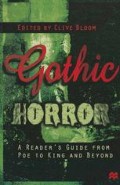Abstract
Montague Rhodes James set out his rules for the ghost story, such as they were, in the various brief prefaces to his collections of tales. Unlike Vernon Lee, he believed it important to establish a setting that was
fairly familiar and the majority of the characters and their talk such as you may meet or hear any day. A ghost story of which the scene is laid in the twelfth or thirteenth century may succeed in being romantic or poetical: it will never put the reader into the position of saying to himself, ‘If I’m not very careful, something of this kind may happen to me!’ (Preface to More Ghost Stories of an Antiquary, 1911).
Preview
Unable to display preview. Download preview PDF.
Notes
Julia Briggs, Night Visitors: The Rise and Fall of the English Ghost Story (London: Faber, 1977).
Cited in Edward Wasiolek, Dostoevsky: The Major Fiction (Cambridge, MA: Harvard University Press, 1964) p. 5.
Jonathan Culler, ‘Literary Fantasy’, Cambridge Review, 93 (1973) p. 33.
Fredric Jameson, ‘Magical Narratives: Romance as Genre’, New Literary History, 7 (Autumn 1975) p. 146.
First published in Brian Docherty (ed.), American Horror Fiction (Basingstoke: Macmillan, 1990).
Suzy McKee Charnas, The Vampire Tapestry (London: Granada, 1983).
For valuable discussions of fantasy literature and the horror genre, and their conventions, see Rosemary Jackson, Fantasy: The Literature of Subversion (London: Methuen, 1981)
David Punter, The Literature of Terror: A History of Gothic Fiction from 1765 to the Present Day (London: Longman, 1980)
M. M. Bakhtin, The Dialogic Imagination, ed. M. Holquist and C. Emerson (Austin: University of Texas Press, 1981).
See’ sexual Politics and Political Repression in Bram Stoker’s Dracula’, in Clive Bloom, Brian Docherty, Jane Gibb and Keith Shand (eds), Nineteenth-Century Suspense: From Foe to Conan Doyle (London: Macmillan, 1988).
First published in Brian Docherty (ed.), American Horror Fiction (Basingstoke: Macmillan, 1990).
H. P. Lovecraft, Supernatural Horror in Literature (New York: Dover, 1973).
See Peter Penzoldt, The Supernatural in Fiction (London: Peter Nevill, 1952).
Rosemary Jackson, Fantasy: The Literature of Subversion (London: Methuen, 1981).
See Nancy Chodorow, The Reproduction of Mothering (Berkeley, CA: University of California Press, 1978)
Carol Gilligan, In a Different Voice: Psychological Theory and Women’s Development (Cambridge, MA: Harvard University Press, 1982)
Jean Baker Miller, Towards a New Psychology of Women (London: Allen Lane, 1978).
A motif traced, in Jungian terms, in Jackson’s work by Steven K. Hoffman, in ‘Individuation and Character Development in the Fiction of Shirley Jackson’, Hartford Studies in Literature, 8 (1976) 190–208.
Elizabeth Abel, Marianne Hirsch and Elizabeth Langland (eds), The Voyage In: Fictions of Female Development (Hanover, NH: University Press of New England, 1983).
Page references in parentheses relate to Shirley Jackson, The Haunting of Hill House (London: Michael Joseph, 1960).
Shirley Jackson, The Sundial (New York: Penguin, 1986) p. 109.
Mrs Montague’s discoveries recall the worst excesses of the ghost hunter, at Borley Rectory in Essex. See Harry Price, The Most Haunted House in England: Ten Years’ Investigation of Borley Rectory (London: Longmans, Green, 1940)
A. Goodrich Freer and John, Marquess of Bute, The Alleged Haunting of Ballechin House (London: George Redway, 1899).
See Peter Underwood, Dictionary of the Occult and Supernatural (London: George G. Harrap, 1978) p. 147.
From J. Gerald Kennedy, Poe, Death and the Life of Writing (New Haven, CT: Yale University Press, 1987).
For a helpful survey of critical responses to Pym see Douglas Robinson, ‘Reading Poe’s Novel: A Speculative Review of Pym Criticism, 1950–1980,’ Poe Studies, 15 (December 1982), 47–54.
J. Gerald Kennedy, ‘The Preface as a Key to the Satire in Pym,’ Studies in the Novel, 5 (Summer 1973), 191–6.
Patrick H. Quinn, The French Face of Edgar Poe (Carbondale, IL: Southern Illinois Press, 1957) pp. 176–7
Edward H. Davidson, Poe: A Critical Study (Cambridge, MA: Harvard University Press, 1957) pp. 168
Jean Ricardou, ‘Le Caractère singulier de cette eau,’ Critique, 243–4 (August–September 1967) pp. 729–30; John Carlos Rowe, Through the Custom-House: Nineteenth-Century American Fiction and Modern Theory (Baltimore, MD: The Johns Hopkins University Press, 1982) pp. 95
John T. Irwin, American Hieroglyphics: The Symbol of the Egyptian Hieroglyphics in the American Renaissance (New Haven: Yale University Press, 1980) p. 117.
David Hoffman, Foe Poe Poe Poe Poe Poe Poe (New York: Doubleday, 1972) p. 192.
J. Gerald Kennedy, ‘The “Infernal Twoness” of Arthur Gordon Pym, Topic’, 30 (Fall 1976) p. 53.
Michel Ragon, The Space of Death: A Study of Funerary Architecture, Decoration, and Urbanism, tr. Alan Sheridan (Charlottesville: University of Virginia, 1983).
Edgar Morin, L’homme et la mort (Paris: Éditions de Seuil, 1970) p. 41.
René Girard, Violence and the Sacred, tr. Patrick Gregory (Baltimore, MD: The Johns Hopkins University Press, 1977) p. 49.
Robert J. Lifton, The Broken Connection (New York: Simon & Schuster, 1980) p. 145.
George Steiner, Language and Silence: Essays on Language, Literature, and the Inhuman (New York: Atheneum, 1976) p. 3.
Maurice Blanchot, The Space of Literature, tr. Ann Smock (Lincoln: University of Nebraska Press, 1982) pp. 91
First published in Manuel Aguirre, The Closed Space: Horror Fiction and Western Symbolism (Manchester: Manchester University Press, 1990).
First published in Clive Bloom (ed.), Creepers (London: Pluto, 1993).
Angela Carter in conversation with John Haffenden, The Literary Review, v (1984) p. 37.
First published in Clive Bloom (ed.), Creepers (London: Pluto, 1993).
The primary source of information and quotes for this feature is Martin Barker’s A Haunt of Fears (London: Pluto Press, 1984).
Editor information
Copyright information
© 1998 Macmillan Publishers Limited
About this chapter
Cite this chapter
Briggs, J. et al. (1998). Contemporary Critical Accounts. In: Bloom, C. (eds) Gothic Horror. Palgrave, London. https://doi.org/10.1007/978-1-349-26398-1_5
Download citation
DOI: https://doi.org/10.1007/978-1-349-26398-1_5
Publisher Name: Palgrave, London
Print ISBN: 978-0-333-68398-9
Online ISBN: 978-1-349-26398-1
eBook Packages: Palgrave Literature & Performing Arts CollectionLiterature, Cultural and Media Studies (R0)

